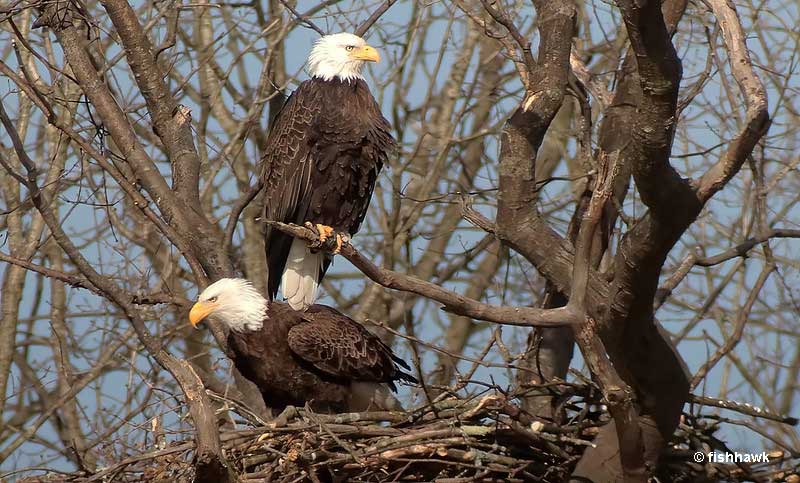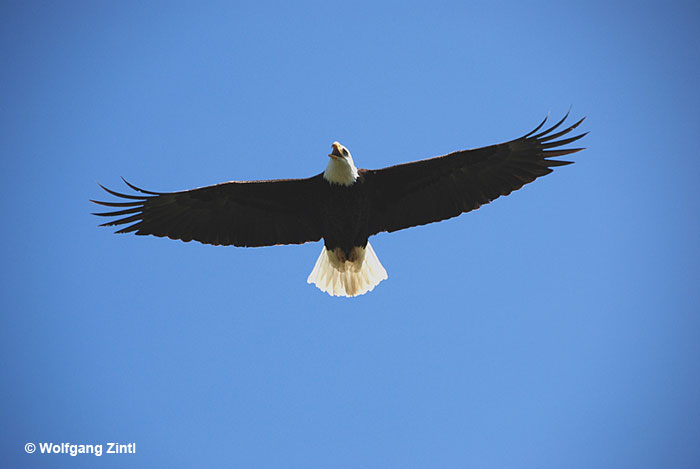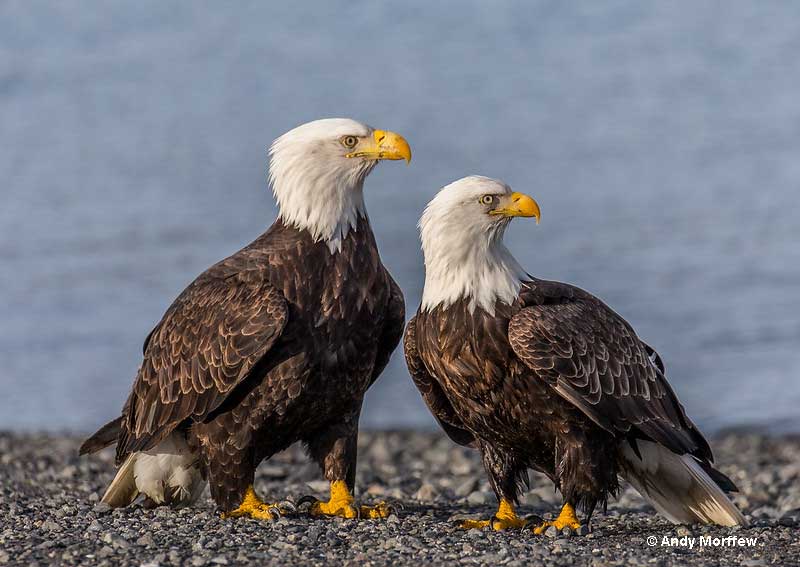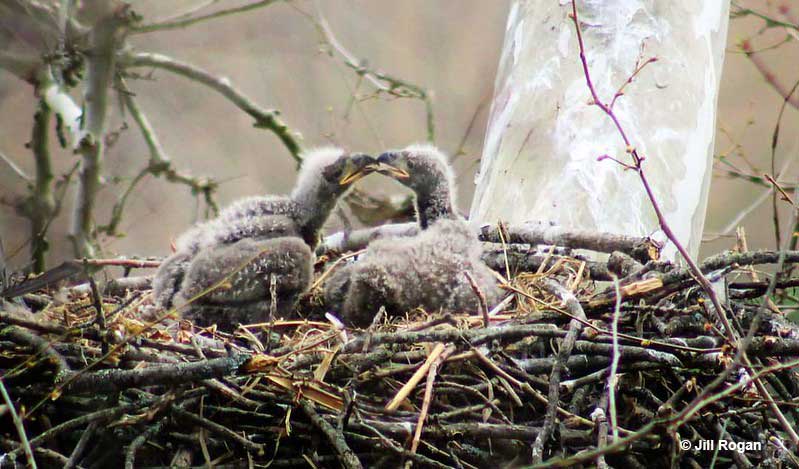
Female eagles, rarely also referred to as “formels”, do not have a specific term used to identify them.
They share a similar appearance with their male counterparts, and there are no easily identifiable differences between the sexes. However, there are two ways to determine whether it’s a male or a female if you take some time to observe them.
Let’s take a closer look then, shall we?
On this page
Female vs Male Eagle
In North America, the eagle population is dominated by two native species: the majestic Bald Eagle with a dark brown body, white head, and yellow bill, and the powerful Golden Eagle, with dark brown plumage, a golden sheen on their head and neck, and a dark bill.

From this angle, it’s almost impossible to identify if it’s a female Bald Eagle or a male Bald Eagle.
However, in certain western regions of Alaska’s mainland, Bering Sea islands, and the Aleutian Islands, two rare visitors, the Steller’s Sea-eagle and the White-tailed Eagle, can also be encountered. The former has a dark brown to black plumage with striking white patches on their wings and legs, whereas the latter is greyish mid-brown overall and has a white tail.
Keep reading: How big are Bald Eagles compared to humans and other birds?
There are two main ways to differentiate between the sexes – size and behavior.
On average, female eagles are approximately 20-25% larger and heavier than their male counterparts.
However, specific measurements may vary depending on the geographic location and species. Additionally, if you only see one bird then it’s rather difficult to estimate the size difference since you don’t have anything to compare it to.
Apart from their physical traits, one can also differentiate between male and female eagles through their behavior. Females primarily take on the role of incubating the eggs and fiercely protecting the nest.
During these times, they exhibit heightened aggression and territorial behavior. In contrast, males focus on hunting to provide food for themselves, their mates, and their offspring, particularly during the breeding season.
Scientific information
| FEMALE EAGLE | MALE EAGLE | |
| SIZE | Larger and heavier | Smaller and lighter |
| APPEARANCE | Larger back talons and a larger hook on their bill. | Slightly smaller back talons and a smaller hook on their bill. |
| PLUMAGE |
Sexes look alike. |
|
| BEHAVIOR | Incubating the eggs. During the breeding season, most often seen near the nest.
More aggressive and territorial when defending their nest.
|
More frequent hunters.
During the breeding season, in particular, they hunt more to feed their mate and offspring.
|
| SOUNDS | Slightly lower-pitched calls | Slightly higher-pitched calls |
Size
Female eagles surpass their male counterparts in size and weight, accompanied by larger beaks and talons, making them the stronger sex. On average, females are 20-25% larger, around 5-10 pounds heavier, and also have a greater wingspan.

Judging by the size, the female is on the left, and the male is on the right. Photograph © Andy Morffew
The size difference gives eagles an evolutionary advantage. The larger size of females enables them to endure longer periods of sitting on the nest while incubating eggs, as larger animals can withstand extended periods without food more easily.
Moreover, the mere presence of a larger female serves as a formidable defender of the eggs. On the other hand, the smaller and more agile males are more adapted to hunting.
Behavior
Some notable differences between the sexes lie in their behavior and the roles they undertake.
Larger females assume the responsibility of sitting in the nest and protecting the precious eggs. During this time, females tend to exhibit heightened aggression and territoriality, displaying a more dominant and protective demeanor.
In contrast, the smaller males are well-adapted to their role as primary hunters. They diligently seek out prey to provide sustenance not only for the growing chicks in the nest but also for the female and themselves.
Related: What is a group of eagles called?
Overall, these behavioral differences showcase the complementary roles played by male and female eagles in ensuring the successful rearing of their offspring.
How To Tell A Younger Eagle’s Gender?

Young eagles in the nest. Photograph © Jill Rogan
Determining the gender of young eagles is even more difficult, if not impossible, based on appearance. Both nestlings and juveniles, regardless of their gender, look identical.
Their plumage changes at the same rates, and variations occur across both sexes. This lack of distinguishing features makes it nearly impossible to visually identify the gender of young eagles.
Reliable gender determination typically requires close examination by experienced researchers.
Lifecycle
Eagles typically have one brood per breeding season, consisting of a clutch with 1-3 whitish eggs. Their size varies by species and geographical location, measuring around 2-2.5 inches wide and 2.5-3.5 inches long.
The incubation period lasts for approximately 5-6 weeks. During this time, the female primarily takes on the task of incubating the eggs, while the male assumes the responsibility of hunting for food.
However, in certain cases, the female may also engage in hunting, and the male will temporarily take over the incubation duties.
The chicks stay in the nest for 6-14 weeks. During this phase, both parents actively participate in caring for the chicks. They tear pieces of food and deliver them to the nestlings, providing the necessary nourishment for their growth and development.
Related: Are Bald Eagles still endangered?
As the nestlings mature, they gradually gain independence, reaching this milestone around 4-11 weeks after the nestling period. Sexual maturity is attained at approximately 4-5 years of age.
In terms of lifespan, eagles typically live an average of about 15 years, although some individuals can reach impressive ages of 20-28 years. The longevity of these majestic birds varies depending on factors such as species, environmental conditions, and availability of food resources.
Female Eagles – Frequently Asked Questions
What do we call a female eagle?
Female eagles don’t have a specific term, but they’re sometimes called formels.
How do you tell a male eagle from a female?
Female eagles are, on average 20-25% larger than males. During the breeding season, females usually stay in the nest, whereas males hunt for food.
Do female eagles have white?
Male and female eagles have the same plumage, so it really depends on the species. For example, Bald Eagles have white heads.
What eagle is bigger male or female?
Female eagles are up to 25% bigger than males. They’re also heavier and have longer wingspans.
Do male eagles sit on eggs?
Female eagles do most of the incubating, but sometimes they take turns so the female can spread her wings and hunt.
What does a female bald eagle look like?
As with other eagles, female Bald Eagles are bigger in size. Apart from that, females look pretty much identical to male Bald Eagles.
Do eagles mate for life?
Eagles are magnificent creatures and are known to mate for life unless their mate dies.
Conclusions
Female eagles are very similar to males, and it’s very difficult to differentiate between the two. There are two main ways to do so: size and behavior.
Females are generally larger and heavier, with larger beaks and talons, making them the stronger sex. They take on the crucial role of incubating the eggs and fiercely protecting the nest, displaying heightened aggression and territorial behavior.
In contrast, males are smaller and focus on hunting to provide food for their mate and offspring.
